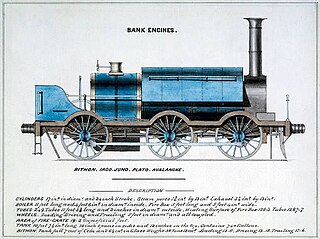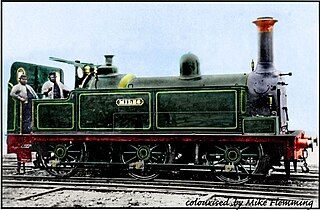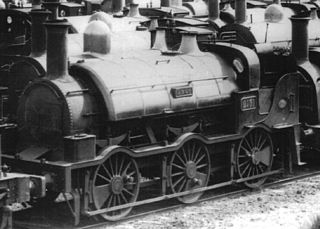
The first Locomotives of the Great Western Railway (GWR) were specified by Isambard Kingdom Brunel but Daniel Gooch was soon appointed as the railway's Locomotive Superintendent. He designed several different 7 ft 1⁄4 in broad gauge types for the growing railway, such as the Firefly and later Iron Duke Class 2-2-2s. In 1864 Gooch was succeeded by Joseph Armstrong who brought his standard gauge experience to the workshops at Swindon. To replace some of the earlier locomotives, he put broad gauge wheels on his standard gauge locomotives and from this time on all locomotives were given numbers, including the broad gauge ones that had previously carried just names.

The Banking Class were five 0-6-0ST Brunel gauge steam locomotives for assisting ("banking") trains up inclines on the Great Western Railway. Designed by Daniel Gooch, they were tank engine versions of his Standard Goods class, and mainly built at Swindon Works.

The Great Western Railway Caesar Class were 0-6-0 broad gauge steam locomotives. They were designed by Daniel Gooch for goods train work. This class was introduced into service between June 1851 and February 1852, and withdrawn between June 1871 and June 1880.

The Great Western Railway Pyracmon Class were 0-6-0 broad gauge steam locomotives for goods train work. This class was introduced into service between November 1847 and April 1848, and withdrawn between August 1871 and December 1873. Bacchus was added to the class in May 1849, having been constructed to broadly the same design from spare parts.
The Great Western Railway (GWR) Bogie Class4-4-0ST were broad gauge steam locomotives for passenger train work. The first two locomotives of this class were introduced into service in August/September 1849, with the remainder following between June 1854 and March 1855. All but one were withdrawn between October 1871 and 1873, with the final locomotive being withdrawn in December 1880.

The Great Western Railway Iron Duke Class 4-2-2 was a class of 7 ft 1⁄4 in broad gauge steam locomotives for express passenger train work.

The Great Western Railway Sir Watkin Class were 0-6-0T broad gauge steam locomotives. They were designed for working goods trains through to the underground Metropolitan Railway in London. This class was introduced into service between December 1865 and the last was withdrawn at the end of the GWR broad gauge in May 1892. They were all named after directors and senior officers of the railway.
The Great Western Railway Swindon Class were broad gauge 0-6-0 locomotives built for goods train work. This class entered service between November 1865 and March 1866, and were withdrawn between June 1887 and the end of the GWR broad gauge in May 1892. The entire class was sold to the Bristol and Exeter Railway between July 1872 and September 1874 and were numbered 96-109, but returned to the GWR when that railway was absorbed. The locomotives were then renumbered 2077-2090; their names were not restored.
The two Remus class locomotives were 0-6-0ST broad gauge locomotives operated by the South Devon Railway, England. They were ordered for working goods trains on the West Cornwall Railway but were also used on passenger trains.

The eight Dido class locomotives were 0-6-0ST broad gauge locomotives operated on the South Devon Railway and Cornwall Railway and associated other adjacent railways. They were designed for goods trains but were also used on passenger trains when required.
The Bristol and Exeter Railway 2-4-0 locomotives were two classes of 2-4-0 broad gauge steam locomotives.
The Bristol and Exeter Railway 0-4-0T locomotives were five small 0-4-0T locomotives built for shunting by the Bristol and Exeter Railway. On 1 January 1876 the Bristol and Exeter Railway was amalgamated with the Great Western Railway, after which the locomotives were given new numbers.
Vale of Neath Railway 0-6-0ST locomotives were 0-6-0ST steam locomotives for working the heavy goods traffic on the Vale of Neath Railway and its associated lines in Wales. The first of 13 broad gauge locomotives entered service in 1854 and the last was withdrawn in 1886. The remaining four were standard gauge locomotives.
The GWR 3501 Class were ten broad gauge 2-4-0 locomotives built by the Great Western Railway.

The GWR 388 class was a large class of 310 0-6-0 goods locomotives built by the Great Western Railway. They are sometimes referred to as the Armstrong Goods or Armstrong Standard Goods to differentiate from the Gooch Goods and Dean Goods classes, both of which were also large classes of standard goods locomotives.

The GWR Hercules Class were four broad gauge steam locomotives for the Great Western Railway. They were its first 0-6-0 locomotives, being built in 1842 by Nasmyth, Gaskell and Company stemming from the company's need for goods locomotives. This resulted in the last four Firefly Class locomotives being modified while still in production. From about 1865, the Hercules Class locomotives became part of the Fury Class, along with the Premier Class locomotives. They were withdrawn between 1870 and 1871.
Hurricane was the second of a pair of steam locomotives built for the Great Western Railway (GWR) by R. & W. Hawthorn & Co. whose design was very different from other locomotives. In order to meet Isambard Kingdom Brunel's strict specifications, a 2-2-2 frame carried the 'engine', while the boiler was on a separate six-wheeled frame.
Thunderer was the first of a pair of steam locomotives built for the Great Western Railway (GWR), England, by R. & W. Hawthorn & Co. whose design was very different from other locomotives. In order to meet Isambard Kingdom Brunel's strict specifications, an 0-4-0 frame carried the 'engine', while the boiler was on a separate six-wheeled frame. The driving wheels were geared 10:27 in order to reduce the cylinder stroke speed while allowing high track speed, in line with the specifications.
The GWR 378 Class was a class of 30 standard-gauge 2-2-2 steam locomotives on the Great Western Railway in Britain. They were introduced in 1866, and the class remained intact until 1898. Several were altered to the 0-6-0 wheel arrangement, and the last was withdrawn from service in 1920.
The LCDR Brigand class was a pair of steam locomotives of the 0-4-2 wheel arrangement supplied to the London, Chatham and Dover Railway (LCDR). They were designed by Patrick Stirling for the Glasgow and South Western Railway (GSWR), which ordered twenty in 1860 from Sharp, Stewart & Co.. At this time, the LCDR needed more locomotives but had little money available, so their locomotive superintendent, William Martley, visited various manufacturers to find out what was available quickly and cheaply. He arranged for two of the locomotives ordered by the GSWR to be delivered instead to the LCDR – they arrived in August 1861, two more being ordered from Sharp, Stewart for the GSWR as replacements.









